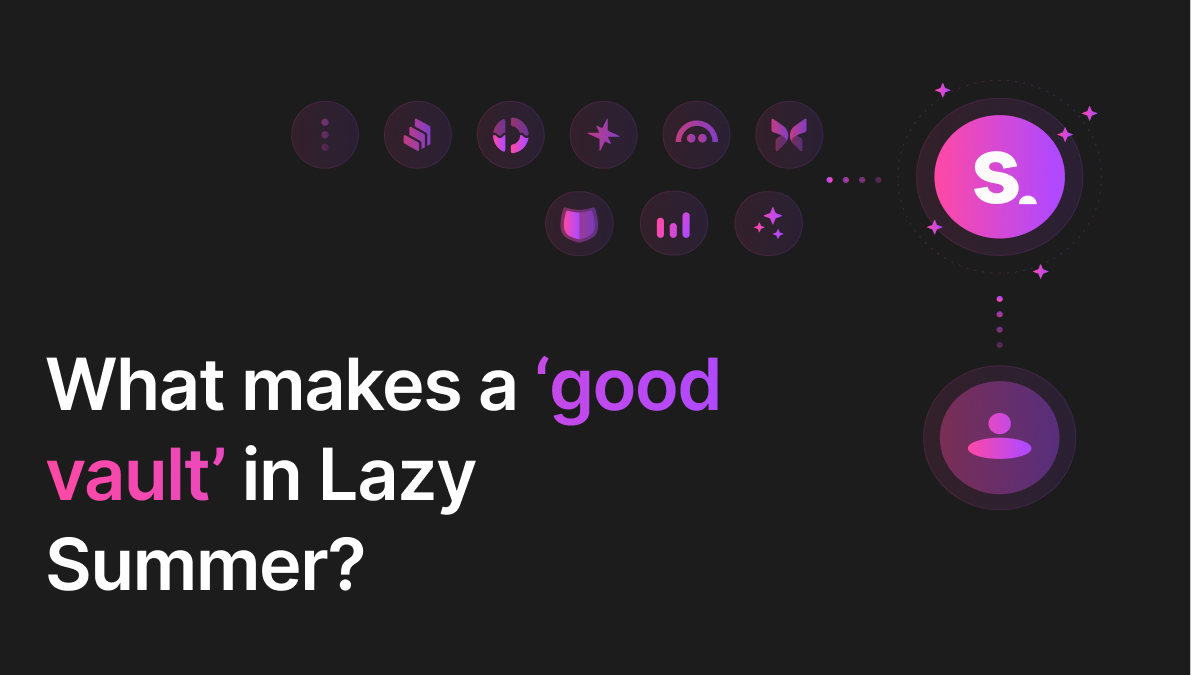What makes a ‘good vault’ in Lazy Summer?

In the Lazy Summer Protocol, a “vault” isn’t just a static yield product—it’s a modular, autonomous yield-maximizing engine. These vaults, called Lazy Vaults, are structured around risk-managed automation, AI-powered upkeep, and smart governance. But what separates a “good” vault from an average one?
1. It Starts with Smart Design: A Modular Fleet Structure
Lazy Vaults operate using a standardized, modular framework. Each vault is technically a Fleet, and it includes:
- Fleet Commander: A core ERC-4626-compatible contract that manages deposits and share issuance.
- ARKs (Automated Revenue Kernels): Individual strategy contracts that plug into the Fleet to execute specific yield opportunities (e.g. lending, staking, farming).
- RAFT: A reward-harvesting system that aggregates and auto-compounds yield across ARKs.
- Buffer ARK: A special ARK for high-liquidity, low-risk assets used to handle withdrawals quickly.
A good vault leverages this modularity by:
- Allocating assets across diverse, complementary ARKs.
- Keeping sufficient liquidity in the Buffer ARK.
- Regularly compounding yield via the RAFT.
2. Balance Between Risk and Return
The protocol doesn’t chase the highest APY blindly. Instead, vaults are constructed with a risk score system in mind, managed by a third-party risk team (Block Analitica). This scoring ensures vaults:
- Are diversified across protocols and assets.
- Limit exposure to high-volatility strategies.
- Stay within strict collateral ratios and usage caps.
A “good” vault achieves risk-adjusted yield, not just headline-grabbing numbers. It’s conservative enough to be resilient, yet aggressive enough to beat passive ETH or LST staking returns.
3. Governance-Tunable & Community-Driven
Vaults are governed—they can evolve over time. Governance can:
- Add or remove ARKs.
- Update strategy parameters like debt ceilings and allocation weights.
- Assign Tips and Fees via the TipJar to incentivize contributors, keepers, and strategists.
This makes vaults living systems that adapt to market conditions and contributor input. Good vaults benefit from active community and delegate participation, allowing them to iterate quickly and remain competitive.
4. Keepers: The Automation Layer
What truly powers Lazy Summer vaults is their AI-driven Keeper Network. These off-chain agents:
- Monitor strategy health.
- Trigger rebalancing when positions drift out of target range.
- Harvest and compound rewards through the RAFT.
A good vault has reliable keeper coverage and clearly defined triggers for action. This ensures it doesn’t underperform due to drift or unclaimed rewards.
5. Accessible, Transparent, and Composable
Good vaults should also be:
- Composable: Built on standardized contracts that integrate with the broader DeFi ecosystem.
- Transparent: All ARKs and parameters are publicly visible and can be queried onchain.
- User-Friendly: With social logins, clear APY breakdowns, and features like “Vault Switching” for seamless migration.
This usability layer makes good vaults not only functionally excellent, but usable by a wide audience, from DAOs to individuals.
In Summary
A good Lazy Summer vault is:
✅ Modular and diversified
✅ Automated with AI-powered agents
✅ Governable and adaptive
✅ Risk-scored and managed
✅ Transparent and easy to use
Lazy Summer’s architecture allows vaults to be deeply composable and fine-tuned over time. But the truly effective ones—the “good” vaults—are those that strike a sustainable balance: automation, risk management, community input, and consistent, real yield.
Want to Earn Smarter?
Lazy Summer is where DeFi meets simplicity. Deposit into any Lazy Summer strategy on summer.fi/earn and let the Lazy Summer Protocol handle the work for you. Whether you're a seasoned DAO or a casual ETH holder, Lazy Vaults offer intelligent, automated yield with less hassle.
👉 Start earning now: https://summer.fi/earn

